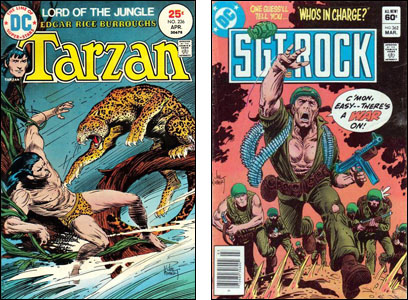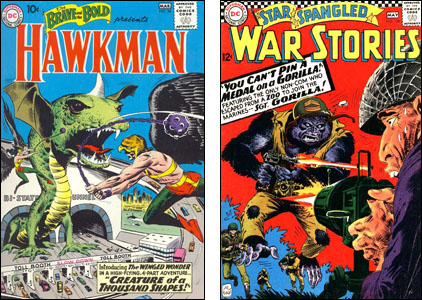
One of comics' most prolific and respected comic book creators, Joe Kubert, died this morning at the age of 85. This probably comes as a special jolt to those who knew him and thought of him as a healthy, vital individual. Joe drew stories of strong, rugged men and unlike so many who do those, seemed like a strong, rugged man himself. Whether it was a war comic, a super-hero comic, a comic about a caveman or his acclaimed run on Tarzan, Joe had a way of imbuing the work with a kind of four-color testosterone. No one did male better.
I suppose in private he had other passions but those who knew him professionally knew of two: He loved to draw and he loved to teach. The love of drawing began at early age. He was born in Poland on September 18, 1926 and brought to the U.S. (to Brooklyn) as an infant. Reared as the son of a Kosher butcher, he started doodling on dad's wrapping paper and soon proved to have the kind of flair on which you could build a career.
Joe told several stories about where and when he got his first professional job. In some, he was as young as ten; in others, as old as thirteen. Even the latter would be amazing. But he started young either in the shop of Harry "A" Chesler or at MLJ, now better known as Archie comics, and was quickly promoted from office boy to art apprentice to artist. He was definitely drawing stories under his own signature by 1942 when he was sixteen. That would have been for a company called Holyoke.

The following year, he did his first work for DC Comics. While he would freelance for many publishers — and briefly be a publisher in partnership with his boyhood friend, Norman Maurer — Joe would do about 90% of his work for DC. In the forties, it was mostly super-heroes, with his stint on Hawkman being especially memorable. In the fifties and sixties, he would become the star "war comics" artist, not just at DC but arguably throughout the industry. His collaborations with writer-editor Robert Kanigher won much praise, particularly on Sgt. Rock and Enemy Ace. He also drew an updated Hawkman and hundreds upon hundreds of covers.
In the seventies, he replaced Kanigher as editor of DC's war titles and branched out into other genres. He also began writing much of what he drew. His version of Tarzan was loved and respected around the world and he later revived Tor, a character he'd done for the line of comics he'd produced with Maurer. Whatever he did, he was a major presence in DC's line. My favorite work of his during this period was a book that didn't get the recognition it deserved — a series called Firehair about a red-headed white boy raised by Indians.
There were other, non-DC projects. For a time, he drew the Tales of the Green Beret newspaper strip and later did brief runs on other features. He began producing PS Magazine, an Army publication once helmed by Will Eisner. But mostly it's been The Joe Kubert School of Cartoon and Graphic Art which he and his wife Muriel ran out of a big house in Dover, New Jersey. Dozens if not hundreds of young artists learned or honed their crafts there, expanding his influence to new generations of comic creators. (He and Muriel also contributed in another way: Two of their sons, Adam and Andy, became top comic book illustrators.)

Everyone loved Joe. Everyone respected Joe. He was among a handful of artists whose speed and natural ability caused others to gape and express their envy. One year at the Comic-Con in San Diego (the same mid-seventies con where I took the above photo), Joe was asked to do a drawing for a charity art auction. He stepped up to an easel with a big, yard-high piece of drawing paper on it. He picked up a box of pastel chalks. He turned to the easel —
— and in under a minute, there was this drawing there of Hawkman. It was an incredible, detailed drawing that might have taken another artist an hour and been a third as good. Other artists working on nearby easels stopped and blinked in amazement.
Moments later, Joe's drawing was auctioned off for hundreds of dollars. Today, it would go for thousands but back then, hundreds seemed steep. The runner-up bidder announced that he would match the winning price — more money for the charity — if Joe would whip out another. Joe took his time on this one. I think he took about a hundred seconds. The buyer of the first drawing complained that this was even better and began trying to negotiate a swap with the fellow who'd commissioned the second.

It didn't always come that easy for Joe. In later years, he worked hard and long on a number of graphic novels, including his award-winning Fax from Sarajevo. He wasn't struggling because of his advanced age. He could draw just as fast as ever, he said. But as he tackled more serious, personal subjects, it became that much more important to get the work right. He always did.
I had the pleasure of knowing Joe Kubert and interviewing him at many conventions. He was thoughtful, sincere and very talented…and very generous when it came to sharing his talents with others. As we've had to do too many times in recent years, our industry mourns a giant, a pioneer and a very wonderful man.